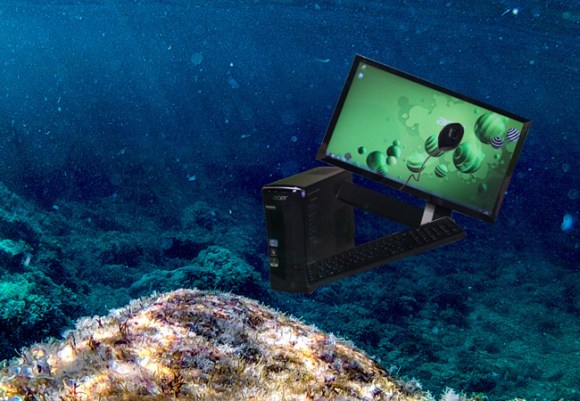
Under the sea. Under the Seaaaaa!♪ You can overclock your processor, under the seaaaaa!♫
■ Hot and bothered
Heat has always been a foe of computers. Especially when pushing them to the limit, users always run the risk of burning out key parts. At those times when you want to get Crysis 3 running nicely, you just wish you could toss that sucker into the sea to cool it down.
Well, that may soon become a realistic option thanks to the efforts of Professors Michihiro Koibuchi and Kazuki Fujiwara of the National Institute of Informatics who have been developing a Suibotsu Computer (Submersible Computer) capable of operating under water.
Common sense tells us that putting a computer into water will result in problems. Of course, the high conductivity of water would easily short it out and then proceed to corrode its sensitive circuitry just to rub it in. But with products like the new iPhone being waterproof, how hard would it be to make a waterproof computer?
■ Trial and error
Quite hard, according to Koibuchi and Fujiwara, who had to trudge through several trial and error approaches. First they discovered a type of epoxy resin that could insulate the electric currents preventing shorts and waterproof to repel the damaging effects of the water. However, it failed because even with the most careful painting it was impossible to completely cover the computer for full protection.
They then tried putting the computer in an aluminum box and sealed the joints with a waterproof substance. But even that couldn’t keep the circuitry completely dry when submerged.
Eventually the pair came across a substance called paraxylene which has similar benefits to the epoxy they previously tried. However, paraxylene had the added ability to be applied in gaseous form. When applying the resin as a gas, the molecular bonds are loose as it coats the surface. Then, when it cools the bonds shrink and tighten creating a firm yet thin waterproof film of about 0.1 millimeters.
■ Take computing for a long walk off a short pier
So Koibuchi and Fujiwara coated a motherboard using this technique and put it in a fish tank full of tap water for three months. During this time, the CPU continuously ran without a problem and at a comfortable temperature.
Next, the professors coated two motherboards to test how seaworthy they would be. In late July they tossed the two boards off a dock in Yokosuka connected to a power source on land by a waterproof cable. It was an unexpectedly rough summer, with early typhoons causing choppy conditions in the sea.
▼ The men used ASRock Mini-ITX motherboards for their tests – a surprisingly expensive choice for something they’re just going to chuck into the ocean
Nevertheless, one of the motherboards had exceeded the researcher’s initial goal of running continuously for one week, and stayed on for an entire month. However, the other motherboard didn’t make it.
After retrieving them from the water, they found that crustaceans and seaweed had begun living on them. A crab had squatted in the case of one motherboard. Seeing this, they deduced that it was likely some shellfish had eaten through the protective layer of the broken board causing it to fail.
Considering the sea run a success, Koibuchi and Fujiwara are now working on waterproofing an entire computer to try out under water. This is much more difficult and requires strategic coating of the resin to balance cooling effects and waterproofing in the areas that need each the most.
■ Environmental boon or bomb?
This is a lot of effort and cost to go through to waterproof a single computer, but the aim of this project is to reduce the cost and energy consumption of large scale data centers. For example, Google’s data centers are said to use about 260 million watts of power (equivalent to 200,000 homes) with much of that power being used for cooling.
Placing these large scale servers in a natural body of water can significantly reduce the environmental impact and cost of the intense 24-hour air conditioning required. Koibuchi and Fujiwara also hope that these underwater servers can be powered by the tides and waves reducing power consumption even more.
Before such a future is achieved, more research will be needed to ensure that the act of putting computer systems into rivers and oceans doesn’t come with other adverse affects to the environment.
But at the very least, we may soon see a future where we no longer have to worry about dropping our desktop PCs in the toilet.
…I have a very small apartment.
Source: NHK, My Game News Flash (Japanese), Storage Servers (English)
Top Image: Wikipedia/Yassin Grayaa, Wikipedia/Michael Movchin (Edited by RocketNews24)
Inset Images: Amazon


 Video shows how computers can become veritable roach motels
Video shows how computers can become veritable roach motels Just how waterproof is this waterproof notebook? We put it to the test, SoraNews24 style
Just how waterproof is this waterproof notebook? We put it to the test, SoraNews24 style Japanese company makes durable cardboard camping domes that are completely recyclable【Pics】
Japanese company makes durable cardboard camping domes that are completely recyclable【Pics】 The long road of the Chusonji Lotus spans nearly a millennium of Japanese history
The long road of the Chusonji Lotus spans nearly a millennium of Japanese history REVIEW: Sony’s new tablet is thinner and lighter than the iPad Air, and Android fans will love it
REVIEW: Sony’s new tablet is thinner and lighter than the iPad Air, and Android fans will love it McDonald’s new Happy Meals offer up cute and practical Sanrio lifestyle goods
McDonald’s new Happy Meals offer up cute and practical Sanrio lifestyle goods All-you-can-drink Starbucks and amazing views part of Tokyo’s new 170 meter-high sky lounge
All-you-can-drink Starbucks and amazing views part of Tokyo’s new 170 meter-high sky lounge Studio Ghibli glasses cases let anime characters keep an eye on your spectacles
Studio Ghibli glasses cases let anime characters keep an eye on your spectacles Studio Ghibli releases new action figures featuring Nausicaä of the Valley of the Wind characters
Studio Ghibli releases new action figures featuring Nausicaä of the Valley of the Wind characters McDonald’s Japan releases a pancake pie for new retro kissaten coffeeshop series
McDonald’s Japan releases a pancake pie for new retro kissaten coffeeshop series Super Nintendo World expansion gets delayed for several months at Universal Studios Japan
Super Nintendo World expansion gets delayed for several months at Universal Studios Japan Daiso opens massive new 25,392-square foot Tokyo flagship store with its two sub-brands included
Daiso opens massive new 25,392-square foot Tokyo flagship store with its two sub-brands included Beautiful Sailor Moon manhole cover coasters being given out for free by Tokyo tourist center
Beautiful Sailor Moon manhole cover coasters being given out for free by Tokyo tourist center Enjoy Kyoto (Part 3) — The ultimate breakfast? Try $45 rice porridge at a 400-year-old restaurant
Enjoy Kyoto (Part 3) — The ultimate breakfast? Try $45 rice porridge at a 400-year-old restaurant The madness ends now: How to conqueror impossible-to-open Japanese convenience store snacks
The madness ends now: How to conqueror impossible-to-open Japanese convenience store snacks More foreign tourists than ever before in history visited Japan last month
More foreign tourists than ever before in history visited Japan last month Disney princesses get official manga makeovers for Manga Princess Cafe opening in Tokyo
Disney princesses get official manga makeovers for Manga Princess Cafe opening in Tokyo Starbucks reopens at Shibuya Scramble Crossing with new look and design concept
Starbucks reopens at Shibuya Scramble Crossing with new look and design concept Beautiful new Final Fantasy T-shirt collection on the way from Uniqlo【Photos】
Beautiful new Final Fantasy T-shirt collection on the way from Uniqlo【Photos】 Is the new Shinkansen Train Desk ticket worth it?
Is the new Shinkansen Train Desk ticket worth it? Foreign English teachers in Japan pick their favorite Japanese-language phrases【Survey】
Foreign English teachers in Japan pick their favorite Japanese-language phrases【Survey】 Studio Ghibli releases Kiki’s Delivery Service chocolate cake pouches in Japan
Studio Ghibli releases Kiki’s Delivery Service chocolate cake pouches in Japan Japan’s bone-breaking and record-breaking roller coaster is permanently shutting down
Japan’s bone-breaking and record-breaking roller coaster is permanently shutting down New definition of “Japanese whiskey” goes into effect to prevent fakes from fooling overseas buyers
New definition of “Japanese whiskey” goes into effect to prevent fakes from fooling overseas buyers Our Japanese reporter visits Costco in the U.S., finds super American and very Japanese things
Our Japanese reporter visits Costco in the U.S., finds super American and very Japanese things Studio Ghibli unveils Mother’s Day gift set that captures the love in My Neighbour Totoro
Studio Ghibli unveils Mother’s Day gift set that captures the love in My Neighbour Totoro Domino’s Japan now sells…pizza ears?
Domino’s Japan now sells…pizza ears? New Japanese KitKat flavour stars Sanrio characters, including Hello Kitty
New Japanese KitKat flavour stars Sanrio characters, including Hello Kitty One of Tokyo’s most famous meeting-spot landmarks is closing for good
One of Tokyo’s most famous meeting-spot landmarks is closing for good Kyoto creates new for-tourist buses to address overtourism with higher prices, faster rides
Kyoto creates new for-tourist buses to address overtourism with higher prices, faster rides Sales of Japan’s most convenient train ticket/shopping payment cards suspended indefinitely
Sales of Japan’s most convenient train ticket/shopping payment cards suspended indefinitely Sold-out Studio Ghibli desktop humidifiers are back so Totoro can help you through the dry season
Sold-out Studio Ghibli desktop humidifiers are back so Totoro can help you through the dry season Japanese government to make first change to romanization spelling rules since the 1950s
Japanese government to make first change to romanization spelling rules since the 1950s Ghibli founders Toshio Suzuki and Hayao Miyazaki contribute to Japanese whisky Totoro label design
Ghibli founders Toshio Suzuki and Hayao Miyazaki contribute to Japanese whisky Totoro label design Doraemon found buried at sea as scene from 1993 anime becomes real life【Photos】
Doraemon found buried at sea as scene from 1993 anime becomes real life【Photos】 Tokyo’s most famous Starbucks is closed
Tokyo’s most famous Starbucks is closed One Piece characters’ nationalities revealed, but fans have mixed opinions
One Piece characters’ nationalities revealed, but fans have mixed opinions We asked a Uniqlo employee what four things we should buy and their suggestions didn’t disappoint
We asked a Uniqlo employee what four things we should buy and their suggestions didn’t disappoint Princesses, fruits, and blacksmiths: Study reveals the 30 most unusual family names in Japan
Princesses, fruits, and blacksmiths: Study reveals the 30 most unusual family names in Japan Japanese company makes emergency natural disaster survival bag for dogs
Japanese company makes emergency natural disaster survival bag for dogs Seven Japanese drugstore beauty products loved by women abroad
Seven Japanese drugstore beauty products loved by women abroad Check the weather forecast with a cool gadget that recreates the conditions in your living room
Check the weather forecast with a cool gadget that recreates the conditions in your living room Aichi man arrested for impersonating Aichi boy to gain social support
Aichi man arrested for impersonating Aichi boy to gain social support With an Evangelion watch on your wrist, “all is right with the world.”
With an Evangelion watch on your wrist, “all is right with the world.” Totoro ready to help keep forests clean this summer with his adorable new reusable shopping bags
Totoro ready to help keep forests clean this summer with his adorable new reusable shopping bags Drone-powered parasols possibly coming to Japanese golf courses in 2019
Drone-powered parasols possibly coming to Japanese golf courses in 2019 Each of Mao Asada’s Olympic performances led to a power station’s worth of electricity demand
Each of Mao Asada’s Olympic performances led to a power station’s worth of electricity demand Japanese genius invents a machine just to help you get out of unwanted video chats【Video】
Japanese genius invents a machine just to help you get out of unwanted video chats【Video】 Mr. Sato broadens his home drinking horizons at Kaldi【Japan’s Best Home Senbero】
Mr. Sato broadens his home drinking horizons at Kaldi【Japan’s Best Home Senbero】 Fresh out of a sci-fi film! Make your own “head in a jar”!【Instructions】
Fresh out of a sci-fi film! Make your own “head in a jar”!【Instructions】 How to put together an earthquake/typhoon preparedness kit at the 100 yen shop
How to put together an earthquake/typhoon preparedness kit at the 100 yen shop Junior high student shut down 444 school websites to “remind teachers they are incompetent”
Junior high student shut down 444 school websites to “remind teachers they are incompetent” Ibaraki Prefecture promotes onsen hot springs with muscly man bathing in 4K【Videos】
Ibaraki Prefecture promotes onsen hot springs with muscly man bathing in 4K【Videos】 Up-and-coming manzai comedian robots AIchan and GONta adorably work on their material
Up-and-coming manzai comedian robots AIchan and GONta adorably work on their material
Leave a Reply